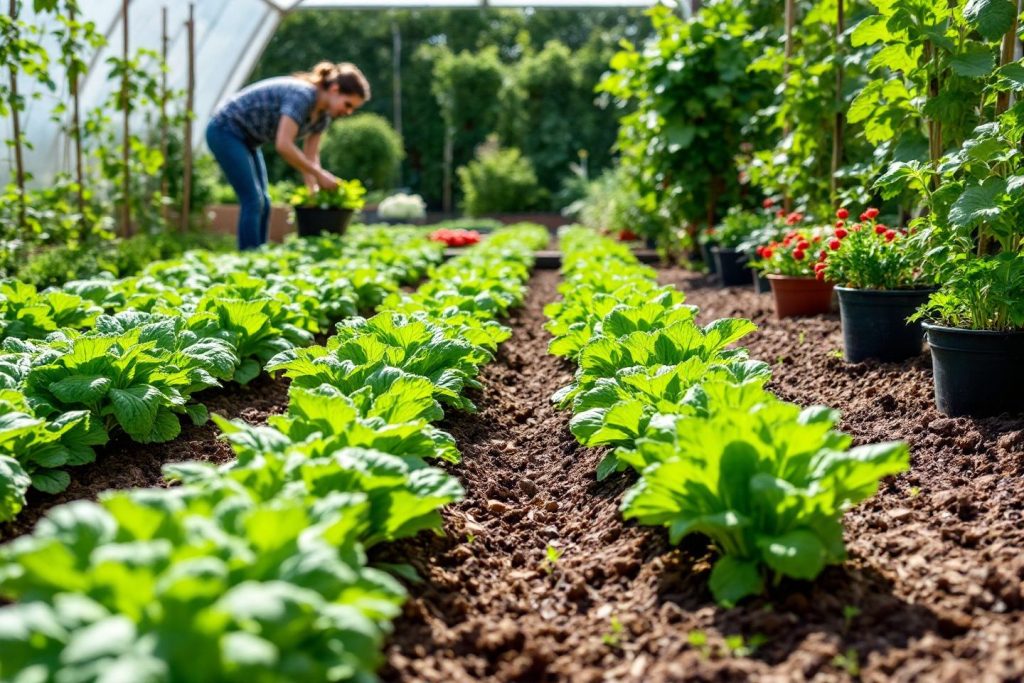I’m excited to share my knowledge about keto gardening. It’s a unique way to grow low-carb vegetables that fit a ketogenic lifestyle. This guide will help you create a thriving keto-friendly garden, whether you’re new to gardening or a seasoned green thumb.
Keto gardening focuses on growing plants that match the high-fat, low-carb principles of the ketogenic diet. By growing your own produce, you’ll have fresh, nutrient-rich vegetables. These are perfect for maintaining your ketogenic diet goals.
In a typical keto diet, about 70-75% of calories come from fat, 20-25% from protein, and only 5-10% from carbs. This makes selecting the right vegetables crucial. We’ll explore the best low-carb vegetables to grow, from leafy greens like Swiss chard to cruciferous plants like broccoli and cauliflower.
Throughout this guide, I’ll share tips on choosing the perfect location for your garden, preparing the soil, and caring for your plants. We’ll also discuss seasonal planting strategies and harvesting techniques. These will help your keto garden thrive year-round.
Introduction to Keto Gardening
Keto gardening is becoming popular among health enthusiasts. It’s about growing low-carb veggies for a ketogenic diet. This method gives you fresh, healthy food right at home. It’s both fulfilling and saves money.
What is Keto Gardening?
Keto gardening is about growing veggies that fit the ketogenic diet. You’ll focus on leafy greens, cruciferous veggies, and some low-sugar fruits. By growing your own keto veggies, you get fresh, organic food all the time.
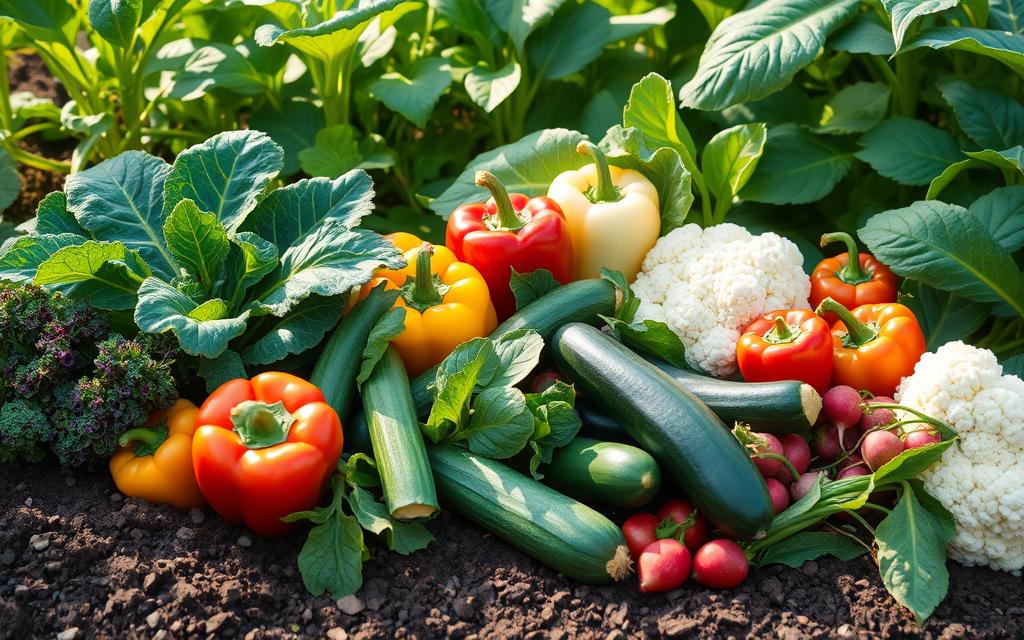
Understanding the Ketogenic Diet
The ketogenic diet is high in fat, moderate in protein, and very low in carbs. It helps your body burn fat for energy instead of carbs. You aim to eat only 20-50 grams of carbs daily.
| Macronutrient | Percentage of Daily Calories | Example Foods |
|---|---|---|
| Fat | 70-80% | Avocados, Olive Oil, Nuts |
| Protein | 20-25% | Eggs, Fish, Meat |
| Carbohydrates | 5-10% | Low-carb vegetables, Berries |
Growing your own low-carb veggies means you always have keto-friendly options. Spinach, radishes, and Swiss chard are great for your keto garden. They’re low in carbs but full of nutrients, helping you stay in ketosis and stay healthy.
Choosing the Right Location for Your Keto Garden
When planning your keto garden, picking the right spot is key. The right location can make your garden a success. Let’s look at the important factors for your keto garden design.
Sunlight Requirements
Most keto-friendly veggies need full sun. I aim for 6-8 hours of direct sunlight each day. Leafy greens like spinach and kale can handle some shade, making them great for less sunny spots.
For indoor gardening, grow lights can be a game-changer. They’re especially helpful for herbs and smaller plants.
Soil Preparation and Drainage
Good soil is essential for a thriving keto garden. I make sure my soil drains well and is rich in organic matter. Here’s my checklist for soil prep:
- Add compost to enrich the soil
- Test and adjust pH levels (aim for 6.0-7.0)
- Improve drainage to prevent root rot
- Use raised beds for better soil control
Remember, good drainage is crucial to avoid moisture issues that can harm your keto-friendly plants.
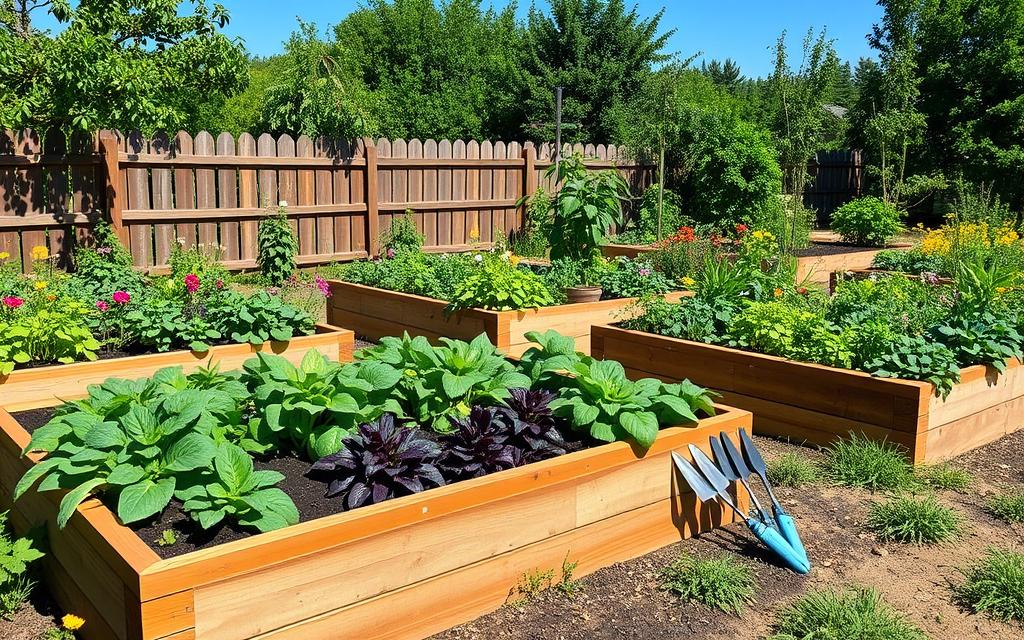
| Plant Type | Sunlight Needs | Soil pH | Drainage Requirement |
|---|---|---|---|
| Leafy Greens | Partial Shade to Full Sun | 6.0-7.0 | Well-draining |
| Root Vegetables | Full Sun | 6.0-6.8 | Excellent drainage |
| Fruiting Vegetables | Full Sun | 6.0-6.8 | Well-draining |
| Berries | Full Sun | 5.5-6.5 | Well-draining |
By focusing on these key elements, you’re setting your keto garden up for success. Whether it’s an outdoor plot or an indoor container garden, these principles will help your garden thrive.
Essential Keto Vegetables to Grow
Growing keto vegetables in your garden is a great way to support your low-carb lifestyle. It saves money and gives you fresh, nutritious produce right at your fingertips.
Leafy Greens
Leafy greens are stars in a keto garden. Spinach, with just 1g net carbs per cup, thrives in cool weather. Swiss chard, a celery substitute, grows easily from seed and tolerates various temperatures. Kale and lettuce round out this nutrient-rich group.
Root Vegetables
Root veggies like kohlrabi, radishes, and turnips are perfect for a low-carb garden. Radishes, for instance, mature quickly and add a crisp bite to salads. They prefer cooler seasons and need about 2-3 inches of space each.
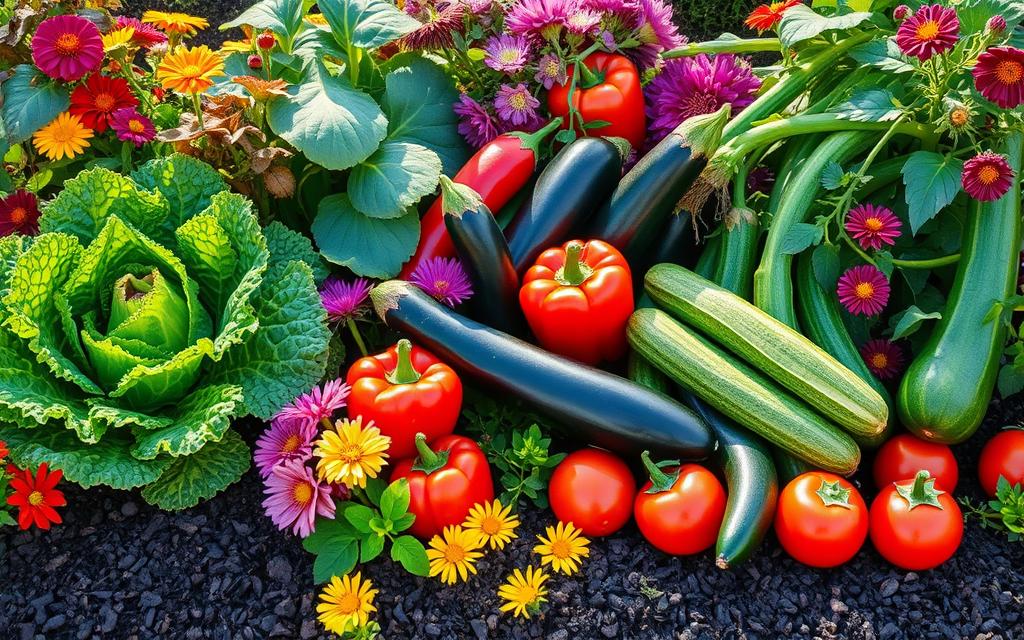
Cruciferous Plants
Broccoli, cauliflower, and Brussels sprouts are nutrient powerhouses. Cauliflower, with only 3g net carbs per serving, is versatile in keto cooking. These plants need ample space and cool temperatures to thrive.
Fruiting Vegetables
Tomatoes, zucchini, bell peppers, and eggplants add variety to your keto garden. While slightly higher in carbs, they’re still keto-friendly in moderation. Bell peppers, for example, contain 4g net carbs per medium pepper.
Berries
Don’t forget about berries! Blackberries, strawberries, and raspberries are low in carbs and high in fiber. They’re perfect for container gardening if you’re short on space.
Remember, most of these low-carb vegetables to grow need 6-8 hours of sunlight daily. Proper spacing in containers ensures good air circulation and healthy growth. With these keto-friendly plants, you’ll have a thriving garden that supports your dietary goals.
| Vegetable | Net Carbs (per serving) | Growing Tips |
|---|---|---|
| Spinach | 1g per cup | Prefers cool weather |
| Radishes | 2g per 7 radishes | Quick-growing, cool season crop |
| Cauliflower | 3g per 1/6 head | Needs ample space |
| Bell Peppers | 4g per medium pepper | Loves sunlight |
| Leaf Lettuce | 1g per 1.5 cups | Easy to grow in containers |
Growing Conditions and Care Tips
Exploring keto garden maintenance, I’ve found key tips for low-carb veggies. Proper care is essential for a thriving keto garden. Let’s look at important keto gardening tips to keep your plants healthy and productive.
Watering and Fertilization
Watering keto vegetables consistently is crucial, especially in hot, dry weather. I use mulch to keep moisture in and weeds out. For fertilizing, I choose organic compost or balanced, low-nitrogen fertilizers. This helps my keto-friendly vegetables grow well without too much leaf.
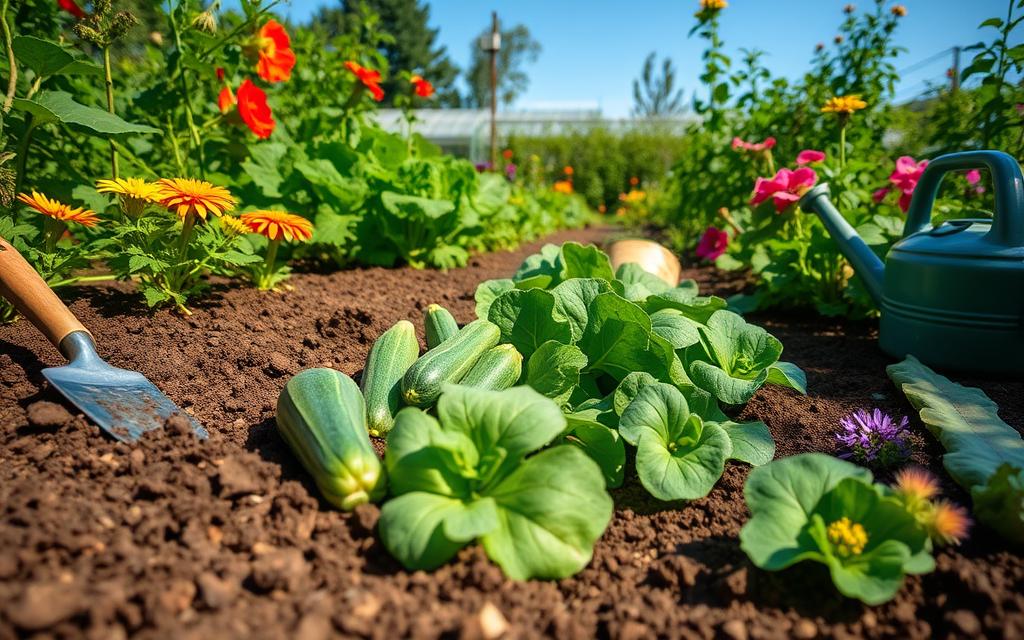
Pest Management and Disease Prevention
To fight pests, I use integrated management techniques. Companion planting and natural predators are very effective. Proper spacing and air circulation prevent fungal diseases. Regularly checking my plants helps me catch and treat problems early.
| Keto Vegetable | Net Carbs per Serving | Key Nutrients |
|---|---|---|
| Bell Peppers | 2-3g | Vitamin C, Calcium, Fiber |
| Broccoli | 4g | Vitamin C, Folic Acid, Fiber |
| Spinach | 1g | Vitamins A, C, K, Iron |
| Tomatoes | 3g | Vitamins A, C, Potassium |
By following these keto gardening tips, my vegetables grow well within the 15-30 grams daily net carb limit. This supports my keto lifestyle and gives me a rich harvest of low-carb produce.
Seasonal Planting Guide for a Keto Garden
Planning a keto garden needs careful thought about when to plant and how to rotate crops. I’ll share some tips to help you get the most from your garden. This way, you’ll always have a fresh supply of low-carb veggies.
Best Planting Times
Knowing when to plant is key for a successful keto garden. Cool-season crops like spinach and kale do well in early spring and fall. Warm-season veggies, like tomatoes, should go in after the last frost.
| Season | Vegetables | Planting Time |
|---|---|---|
| Spring | Leafy greens, radishes, kohlrabi | Early spring |
| Summer | Tomatoes, peppers, zucchini, eggplants | After last frost |
| Fall | Kale, Brussels sprouts, turnips | Late summer |
| Winter | Garlic, winter squash | Late fall |
Crop Rotation and Succession Planting
Crop rotation is a must for a keto garden. It keeps the soil healthy and prevents pests. I move each plant family to a different bed every year. This keeps my veggies healthy and productive.
Succession planting is also crucial. I plant small amounts of fast-growing crops like lettuce every 2-3 weeks. This way, I always have fresh, low-carb veggies for my meals.
By using these techniques, I’ve built a thriving vertical indoor garden. It’s full of keto-friendly veggies all year. With the right planning and care, you can have a keto garden too!
Harvesting and Storing Your Keto Produce
Keto vegetable harvesting is a rewarding process. It marks the end of your gardening efforts. I’ve found that picking vegetables at the right time ensures optimal flavor and nutritional value for your keto meals.
When and How to Harvest Different Vegetables
For leafy greens like spinach and lettuce, I pick outer leaves regularly. This lets the plant keep growing. Root vegetables are ready when they reach the desired size. Fruiting vegetables benefit from frequent harvesting to encourage continued production.
| Vegetable | Harvest Time | Method |
|---|---|---|
| Lettuce | 4-6 weeks after planting | Cut outer leaves, leaving inner leaves to grow |
| Tomatoes | 60-80 days after planting | Pick when fully colored and slightly soft |
| Zucchini | 50-60 days after planting | Harvest when 6-8 inches long |
Tips for Preserving Freshness
Storing keto produce properly is crucial. I wrap most vegetables in paper towels and store them in the refrigerator. This helps absorb excess moisture. For peppers and cucumbers, I use perforated plastic bags. Tomatoes and eggplants are best kept at room temperature.
For long-term storage, I freeze or dehydrate excess produce. This method works well for berries and herbs. It allows me to enjoy home-grown keto-friendly ingredients year-round. By following these harvesting and storing techniques, I ensure a steady supply of fresh, low-carb vegetables for my keto diet.
Conclusion
Keto gardening changes how we eat and live. It lets us grow healthy, low-carb veggies at home. Let’s look at why starting a keto garden is so great.
Recap of the Benefits of Keto Gardening
Keto gardening gives us fresh, low-carb food that fits our diet. For example, spinach has only 1 gram of carbs per cup when raw. Kale has 2 grams of net carbs per cup. These tips for growing your own low-carb can help you make the most of your garden.
Encouragement to Start Your Own Keto-Friendly Garden
I urge you to start your keto gardening today. You can have a great garden, no matter the size of your space. Raised beds help with drainage and keep plants at the right temperature.
Most keto-friendly plants do well in a slightly acidic to neutral soil pH of 6.0 to 7.0. Companion planting can help your plants grow better and keep pests away.
Starting a keto garden is good for your diet and is very rewarding. You’ll enjoy growing your own food, save money, and help the environment. So, get your gardening tools ready and start growing your own low-carb, healthy veggies. Your health and taste buds will love it!
FAQ
What is keto gardening?
What are the benefits of keto gardening?
What kind of sunlight do keto vegetables need?
What are some examples of keto vegetables to grow?
How do I care for my keto garden?
When is the best time to plant keto vegetables?
How do I harvest and store keto produce?
Source Links
- Keto Gardening – How To Plant A Keto-Friendly Garden
- Keto Gardening: How To Plant A Keto Vegetable Garden
- FROM HYDROPONICS TO VEGAN KETO DIET (2 BOOKS IN 1): Homegrown High Quality Organic Fruit, Herbs and Vegetables. Set Up Your Ketogenic Diet Also Using Vegetables and Fruit from your Vegetable Garden
- The Keto Garden: Best Low-Carb Vegetables to Grow • Homestead Lady
- The BEST Keto Foods that You Can Grow in Your Backyard: A Guide to Homegrown Low-Carb Goodness
- How to Start a Keto Vegetable Garden (with tips for Winter Gardening)
- Keto Gardening – Best 10 Keto Friendly Fruit And Vegetable Plants To Grow Indoors
- The Best Summer Vegetables to Grow for Low-Carb Diets
- Planning a Keto Garden
- Should You Add These Keto-Friendly Vegetables to Your Diet?
- The Top 5 Plants to Grow & Eat for the Keto Low-Carb Diet
- What I grow in my keto garden
- How to Grow a Keto Container Garden at Home
- Building My (Sort of) Keto Garden | Dot2Trot
- 15 Easy Keto Friendly Vegetables To Grow In Your Garden – The Small Town Homestead
- Tips for growing a Keto Garden low-carb produce | VEGEGA

